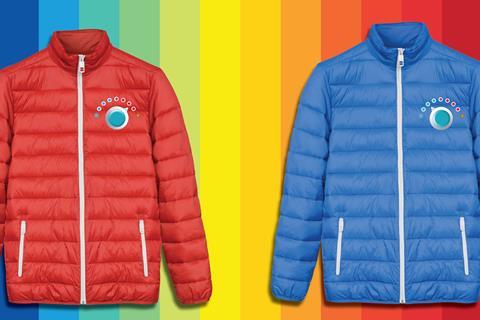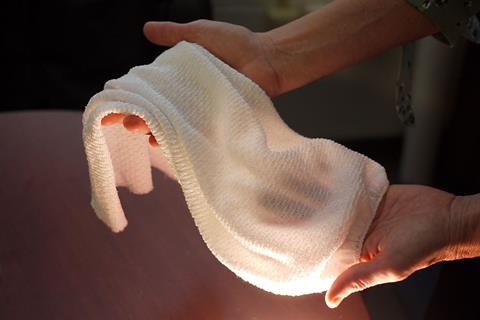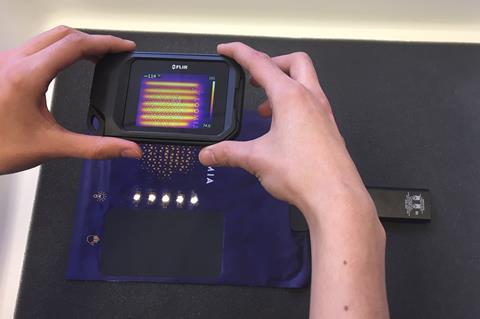Nina Notman gets a feel for the high-tech fabrics that can help us maintain our preferred temperature
Temperature variations in space are vast. Astronauts on a spacewalk at the International Space Station, for example, are exposed to temperatures ranging from -155°C to 120°C, depending on where they are in their Earth orbit. For as long as they have been sending people into space, space agencies have been trying to develop improved spacesuit designs and materials to help astronauts maintain a comfortable temperature as they work.
Phase change
In the 1980s, NASA started exploring phase change materials for this purpose. These are typically paraffin waxes that – just like candle wax – melt when heated and solidify when cooled. The change of phase from solid to liquid in these materials is accompanied by the absorption and storage of large amounts of thermal energy. The reverse transition, from liquid to solid, releases the stored energy as heat. When embedded in spacewear, this reversible process can help astronauts maintain a consistent temperature.

The potential for Earth-based applications for NASA’s phase change materials has been quickly realised. Since the late 1990s, a number of different paraffins – embedded in microcapsules – have been commercialised. These have a variety of both melting points and energy storage capacities, enabling them to be used for applications ranging from sportswear to workwear to bedding.
These include both warming and cooling applications. In ski apparel, for example, pads containing warming phase change materials produced by Swiss textile company Schoeller Technologies have been on the market since the late 1990s. ‘The paraffins go into pads which are then embedded into garments in locations where the temperature exchange is very intensive, such as the breast area and on the back side,’ explains Hans Kohn, chief operating officer at Schoeller. ‘It’s not necessary to have the entire garment made out of the fabric; it’s enough to regulate only specific body areas,’ he adds. Schoeller also produces cooling phase change materials for applications including bulletproof vests. ‘Phase change materials can help to increase the comfort of wearing thick bulletproof vests,’ explains Hans.
In your class
Textile technology is a fast developing area of material science. Many of our students will own smart textiles, from Teflon coated school shirts designed to repel stains, to socks enhanced with silver nanoparticles for preventing smells. This article showcases some of the very latest developments in textile technology, providing useful background reading for students. Use the article in class to help students develop skills in reading comprehension or use the accompanying activity to generate data to analyse which is the best smart jacket.
Cooling bed sheets are a huge and growing market for both Schoeller and its competitors in this field, such as US-based Outlast Technologies. ‘More and more people are looking for products which can improve their sleep,’ says Hans. ‘We also make a mattress that has a winter side and a summer side. The winter side is the warming side and you turn it around in summertime and it will give you a cooling effect.’

Phase change materials are also now being used in business-appropriate attire produced by Ministry of Supply, a company set up by academics at the Massachusetts Institute of Technology (MIT) in the US. ‘Some people at MIT figured out a way to apply this NASA-developed technology to everyday work clothing to help you control your body temperature,’ explains Rebeccah Pailes-Friedman, professor of industrial design at the Pratt Institute in New York City and author of the book Smart textiles for designers: Inventing the future of fabrics.
Adaptive pores
NASA weren’t the first to come up with the idea of designing smart fabrics to better facilitate temperature regulation. ‘The Lacoste tennis shirt was the first performance textile,’ says Rebeccah. In the late 1920s, tennis superstar René Lacoste was on a quest to move the sport away from the formal and restrictive uniform of long trousers, long-sleeved button-down shirt and a tie. He teamed up with André Gillier to create the piqué knit cotton for use in his now famous polo shirt design. ‘They looked at the construction of a normal knit and they created a knit that had a lower surface area on the side that touches your body than on the side that was facing the outside of your body,’ Rebeccah says. Moisture is wicked away from the body to the outer surface with the greater surface area, where it evaporates. ‘That evaporative cooling reduces your body temperature,’ she explains. The effect is quite small, ‘but when it was invented, it was revolutionary.’ Today, many performance fabrics utilise this evaporative cooling concept.
Download this
Investigation, for age ranges 7–11 and 11–14
Use the smart textile context to investigate the insulating properties of various materials, including some mentioned in the article, and discover which material makes the warmest jacket. This activity can be used alongside teaching thermal insulation in physics, with a science club or as an activity to generate and evaluate data.
Download the activity as MS Word and pdf, as well as the accompanying results table as MS Word and pdf.
Use the smart textile context to investigate the insulating properties of various materials, including some mentioned in the article. Which material makes the warmest jacket? This activity can be used alongside teaching thermal insulation in physics, with a science club or as an activity to generate and evaluate data. Download the activity and accompanying results table from the Education in Chemistry website: rsc.li/31RifgB
Others contain technologies with pores that change size in response to body temperature. Schoeller’s c_change membrane is a popular example. C_change mimics the behaviour of the scales on a pine cone, which open and close in response to the weather. When it’s warm and dry (suitable conditions for dispersal and germination) the scales open to release the seeds, and when it’s cold and wet, they close up. ‘C_change is a temperature-regulating membrane produced from a temperature- and humidity-sensitive polymer,’ explains Hans. The polymer has a microporous structure that swells in response to sweat and heat. This structural swelling enlarges the pores, allowing more sweat and body heat to escape. When the wearer cools down, the pores contract and the insulating properties of the fabric are restored. The side of the membrane facing away from the body is also waterproof, and this fabric is typically used in waterproof outerwear.

In February 2019, chemists at the University of Maryland in the US revealed a coated fibre that autonomously changes structure in response to body heat. The team’s cellulose-based fibres are coated with a thin layer of carbon nanotubes. The carbon layer is designed to tighten around the fibres when it gets hot, creating gaps in the fabric that allow heat to escape. Once the wearer cools down, the nanotubes will expand again and the gaps in the fibre shrink. This development could lead to ‘wearable localised thermal management systems that are autonomous and self-powered’.
Electronic textiles
The electronic textile, or e-textile, market – fabrics that contain digital components – is also now looking at temperature control. In January 2018, for example, fashion retailer Ralph Lauren revealed a heated jacket as part of the exclusive range it had designed for the US team to wear at the 2018 Winter Olympics in (extremely cold) Pyeongchang, South Korea. The jacket was designed similarly to an electric blanket. But instead of containing stiff and heavy wires, heat is transported around the fabric using a flexible, lightweight carbon and silver ink. This conductive ink was developed by the US chemical company DuPont. In January 2020, Ralph Lauren started selling the technology to the public. The Polo 11 Heated Jacket is on the market for a cool £999.

This coat requires you to turn the heat up and down manually, using a smartphone app. However, start-up technology company LOOMIA is developing a heating technology with built-in sensors that can control the temperature of the wearer autonomously. Again, a conductive ink is being used instead of wires, resulting in an ultra-thin, almost weightless and highly flexible textile, according to the New York company. LOOMIA has started producing prototypes for some big brands such as Calvin Klein and The North Face. ‘The first product they did with it was a woman’s boot with [a] heating element. and they’re now working on a sport coat-type jacket that keeps you warm,’ explains Rebeccah.
Mimicking nature
Recent years have seen a growing interest in addressing sustainability issues within the fashion industry, and the temperature-control area is no exception. Eight years ago, for example, Schoeller launched a warming corkshell technology that contains natural cork. ‘This is very unique in the market,’ explains Hans, ‘we are replacing petrochemical products with a cork product.’ Cork is well known for its insulation and breathability properties: it’s widely-used as a natural insulation material for building and the popularity of corks for wine bottles is in part thanks to it allowing in tiny amounts of oxygen to support wine ageing. But because of its natural rigidity, it’s hard to imagine it being used in clothing.
The key is to use granulated cork. ‘We’re using cork powder to create thermal insulating layers on fabrics,’ explains Hans. ‘We can tremendously improve the insulation property of a fabric just by adding a few grams of product on the back side.’ Granulated cork is a by-product from wine cork manufacture; Schoeller pulverise it and put in a polymer matrix to make a coating or a foam. The technology is also water- and windproof, making outerwear one of its main markets.
Recent decades have seen a boom in technologies on the market capable of supporting temperature regulation and their range of applications have now expanded beyond the niche. ‘These are breaking into the mainstream and there’s a number of clothing brands that are actively working on incorporating these technologies,’ says Rebeccah. She is particularly excited about their use in everyday clothing: ‘That’s a tremendous market and tapping into [it] is only going to lead to the growth of this area of smart textiles.’
More recommended resources
- Pdfs from That’s chemistry (ages 4–11): Investigating materials with younger students? This book covers key ideas of physical science that primary students learn about, as well as giving numerous suggestions of activities, demonstrations and investigations that can be used to enhance students’ learning.
- A CPD course for teachers wishing to improve their knowledge of materials.
- Olympic Materials (11–16): Resources for a lesson about advances in sporting materials, including a Powerpoint presentation, lesson activities and teacher notes.
- Olympic composites (11–16): Find out about composites used in sport equipment material with these resources, including Powerpoint presentation, teacher notes, student worksheets and practical activity.
- Find out how knowledge about polymers can be used to develop new products in this profile of a consumer products technician.
- Pdfs from That’s chemistry (ages 4–11): Investigating materials with younger students? This book covers key ideas of physical science that primary students learn about, as well as giving numerous suggestions of activities, demonstrations and investigations that can be used to enhance students’ learning: rsc.li/31Qeecl
- A CPD course for teachers wishing to improve their knowledge of materials: rsc.li/38kShoa
- Olympic Materials (11–14, 14–16): Resources for a lesson about advances in sporting materials, including a Powerpoint presentation, lesson activities and teacher notes: rsc.li/31YeW7y
- Olympic composites (11–14, 14–16): Find out about composites used in sport equipment material with these resources, including Powerpoint presentation, teacher notes, student worksheets and practical activity: rsc.li/2vtsWtO
Article by Nina Notman, a freelance science writer and editor specialising in chemistry. Resource by Kristy Turner, a school teacher fellow at University of Manchester/Bolton School, UK.









No comments yet